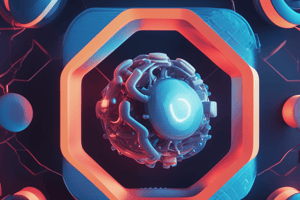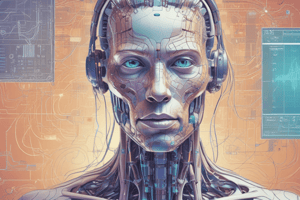Podcast
Questions and Answers
Which of the following best describes the role of AI in modern medical practice?
Which of the following best describes the role of AI in modern medical practice?
- To completely replace human clinicians and reduce healthcare costs.
- To serve as a tool for augmentation, assisting clinicians in making informed decisions. (correct)
- To independently diagnose and treat patients without human intervention.
- To manage administrative tasks, such as scheduling and billing, within healthcare facilities.
In the context of AI in medicine, what is the primary function of Natural Language Processing (NLP)?
In the context of AI in medicine, what is the primary function of Natural Language Processing (NLP)?
- Analyzing medical images to detect anomalies.
- Extracting and interpreting text data from electronic health records. (correct)
- Predicting disease progression based on genetic factors.
- Assisting in robotic surgeries through augmented reality.
Which of the following is a key application of AI in the field of radiology?
Which of the following is a key application of AI in the field of radiology?
- Detecting tumors, fractures, and lung diseases in medical images. (correct)
- Genetic sequencing for cancer diagnostics.
- Interpreting ECG data to detect arrhythmias.
- Monitoring glucose levels in diabetic patients.
What is a significant ethical consideration regarding the use of AI in medical diagnosis?
What is a significant ethical consideration regarding the use of AI in medical diagnosis?
How do AI-driven Clinical Decision Support Systems (CDSS) primarily assist healthcare professionals?
How do AI-driven Clinical Decision Support Systems (CDSS) primarily assist healthcare professionals?
In what capacity is AI being utilized within the field of laboratory medicine and genomics?
In what capacity is AI being utilized within the field of laboratory medicine and genomics?
Which statement accurately describes the future role of AI in medical diagnostics?
Which statement accurately describes the future role of AI in medical diagnostics?
What is the primary goal of using AI in dermatology?
What is the primary goal of using AI in dermatology?
Which aspect of AI implementation is crucial to ensure its effectiveness and acceptance in healthcare settings?
Which aspect of AI implementation is crucial to ensure its effectiveness and acceptance in healthcare settings?
In the context of cardiology, how is AI primarily utilized?
In the context of cardiology, how is AI primarily utilized?
Flashcards
AI in Medicine
AI in Medicine
Computer systems mimicking human intelligence for learning, reasoning, and decision-making in medicine.
Machine Learning (ML)
Machine Learning (ML)
Using statistical techniques to find patterns in data, common in image analysis.
Natural Language Processing (NLP)
Natural Language Processing (NLP)
Extracting and interpreting text data from electronic health records.
Computer Vision
Computer Vision
Using AI for image recognition in radiology and pathology.
Signup and view all the flashcards
Expert Systems
Expert Systems
AI systems designed to assist in clinical decision-making.
Signup and view all the flashcards
AI in Laboratory Medicine and Genomics
AI in Laboratory Medicine and Genomics
AI analyses large datasets from genetic sequencing for cancer diagnostics
Signup and view all the flashcards
Bias in AI
Bias in AI
AI models may reflect biases in training data.
Signup and view all the flashcards
Data Privacy and Security
Data Privacy and Security
Protecting patient data from breaches.
Signup and view all the flashcards
Regulatory Issues
Regulatory Issues
AI models must be validated and approved.
Signup and view all the flashcards
Clinician-AI Collaboration
Clinician-AI Collaboration
AI should assist, not replace, human doctors.
Signup and view all the flashcardsStudy Notes
- The presentation discusses the role of Artificial Intelligence in medical diagnosis
- The target audience is 6th-year medical students
- Aim: To introduce AI applications, explain principles, discuss challenges, and explore future trends
Introduction to AI in Medicine
- AI refers to computer systems mimicking human intelligence for tasks like learning, reasoning, and decision-making
- AI increases medical data complexity
- AI reduces diagnostic errors
- AI enhances decision-making
- AI improves patient outcomes and supports healthcare professionals
- Types of AI in medicine include: Machine Learning (ML), Natural Language Processing (NLP), Computer Vision, and Expert Systems
Machine Learning (ML)
- ML uses statistical techniques to analyze data patterns, such as deep learning in image analysis
Natural Language Processing (NLP)
- NLP extracts and interprets text data from electronic health records (EHRs)
Computer Vision
- Computer Vision does AI for image recognition in radiology and pathology
Expert Systems
- Expert Systems are AI systems assisting in clinical decision-making
AI in Medical Imaging and Diagnosis
- In Radiology, AI detects tumors, fractures, and lung diseases in X-rays, CT scans, and MRIs
- In Pathology, AI assists histopathology for cancer diagnosis
- In Dermatology, AI-based skin cancer detection uses deep learning
- In Cardiology, AI interprets ECGs, detects arrhythmia, & predicts heart failure
- In Ophthalmology, AI detects diabetic retinopathy, glaucoma, and macular degeneration
AI in Clinical Decision Support Systems (CDSS)
- AI helps clinicians make evidence-based decisions
- Example: IBM Watson Health processes vast medical literature to recommend treatments
- AI models predict disease progression, such as sepsis risk prediction
AI in Laboratory Medicine and Genomics
- AI analyzes large datasets from genetic sequencing for cancer diagnostics
- AI helps predict disease risk based on genetic factors
Ethical Considerations and Challenges
- AI models may reflect biases in training data
- Important to focus on Data Privacy and Security by protecting patient data from breaches
- AI models must be validated and approved due to regulatory issues
- Emphasize Clinician-AI Collaboration where AI should assist, not replace, human doctors
- AI decisions must be interpretable for Trust and Explainability
Future of AI in Medical Diagnosis
- AI-augmented reality (AR) for surgery is forthcoming
- AI-driven robotic diagnostics are being developed
- Integration of AI with wearable health devices is in progress
Conclusion
- AI aims to revolutionize medical diagnosis, but must be implemented ethically and responsibly Key Take Away: AI is a tool for augmentation, not replacement, in clinical practice
Studying That Suits You
Use AI to generate personalized quizzes and flashcards to suit your learning preferences.




